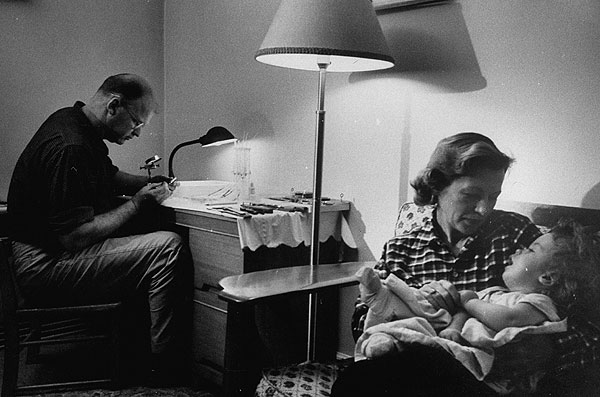Holter's Brain Drain
Today, Neurosurgeon Peyman Pakzaban tells a story about a father and his son. The University of Houston presents this series about the machines that make our civilization run, and the people whose ingenuity created them.
Imagine a father racing against time to invent a device to save the life of his son. John W. Holter worked as a machinist for a lock company in 1955 when his son, Casey, was born. Casey was diagnosed with hydrocephalus at birth. Too much fluid was building up inside his brain. In those days, most patients with hydrocephalus died or suffered brain damage.
Six years before Casey's birth, two Philadelphia neurosurgeons, Spitz and Nulsen, had come close to a solution for hydrocephalus. They had made a brain drain — a shunt. This was a tube implanted under the scalp with one end in the brain, the other in the jugular vein. Its purpose was to drain excess brain fluid into the bloodstream. To prevent the backflow of blood into the brain, the tube had a crude one-way valve, made of metal balls and springs. Alas, the valve often malfunctioned. As far as we know, only one patient was ever helped by this shunt.
To keep 5-week-old Casey alive, a needle had to be inserted each day through the soft spot in his skull to remove the excess fluid. Dr. Spitz told Holter about his shunt. He also told him about the problems with the valve and the high likelihood of failure. Holter headed home, locked himself up in his garage, and three weeks later emerged with the first prototype of what would later be called the Spitz-Holter shunt.

John Holter works on his shunt, while his wife holds Casey.
Holter's simple and elegant solution was a slit valve in polyvinyl chloride tubing. It worked much like the nipple on a baby bottle. When the brain fluid pressure became dangerously high, the rubber would stretch and the valve would open so that the fluid could get through. Unfortunately, polyvinyl chloride deformed in high temperatures and could not be sterilized.
As Casey's condition worsened, Holter frantically searched for another material. He found out about silicone and convinced a rubber company to make his shunt out of silicone. But Holter's shunt was ready a week too late. They had to give Casey the old ball and spring shunt. During that surgery, he suffered severe brain damage and died a few years later. A week after that operation, another child received Holter's first shunt and fully recovered.
After his son's death, Holter made it his life's mission to perfect his shunt and make it available to others. His invention is still in wide use, and it has saved countless lives. Holter, who he did not have a college education, received an honorary doctorate for his work and became the first non-physician member of the American Association of Neurological Surgeons. While Casey's dire need plunged Holter into the inventive process, Casey's death galvanized Holter's resolve and afforded him the closure he needed to complete the methodical process of invention.
I am Peyman Pakzaban at Houston MicroNeurosurgery, where we're interested in the way inventive minds work.
Boockvar, J. A., Loudon, W., & Sutton, L. (2001). Development of the Spitz-Holter valve in Philadelphia. Journal of Neurosurgery , 95, 145-147.
Medicine: Drain for the Brain. (1956, October 29). Time.
Young, D. G. (2004). In Memoriam: Dr. John W. Holter. Journal of Pediatric Surgery , 39 (6), 997.
John Holter works on his shunt photo by Fritz Goro/Time &Life/Getty Images.

A modern programmable shunt and its programming wand. The opening pressure of the this shunt valve can be adjusted before or after the shunt is implanted, allowing the shunt to be fine tuned with respect to cerebrospinal fluid dynamics of individual patients. An integrated anti-siphon device prevents over-drainage of cerebrospinal fluid when the patient stands.